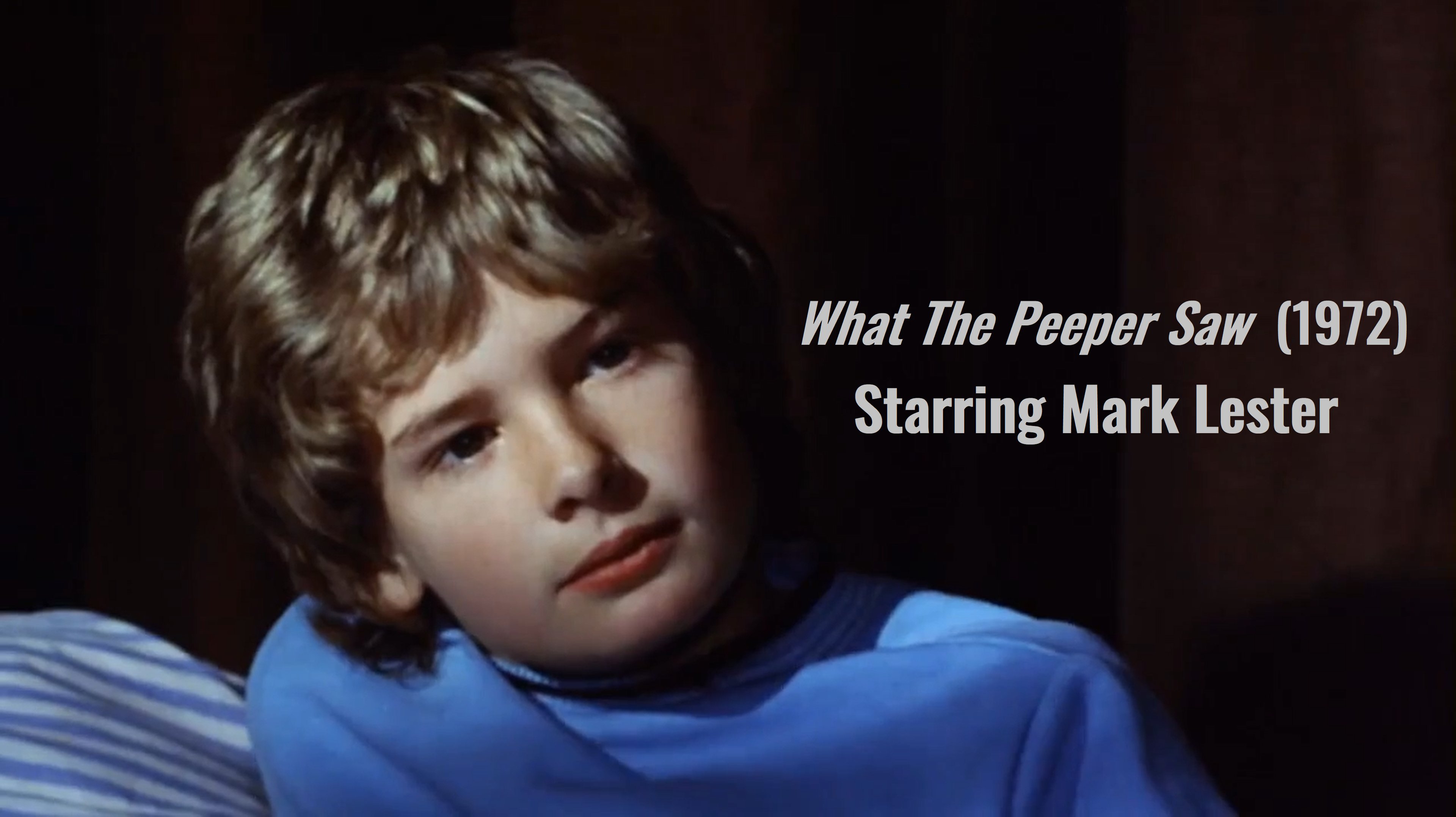🎬🎬 What the Peeper Saw(1972)

What the Peeper Saw: A Chilling Dive into Manipulation and Doubt

What the Peeper Saw (1972), also known as Night Hair Child, directed by James Kelley, is a haunting psychological thriller that delves into the unsettling realms of manipulation, paranoia, and buried family secrets. With its eerie atmosphere and morally ambiguous characters, the film stands as a striking, if underappreciated, gem of the 1970s thriller genre. Anchored by strong performances and a narrative that keeps viewers guessing, What the Peeper Saw masterfully explores the fragility of trust and the blurred line between innocence and malevolence.
A Disturbing Tale Unfolds

The story centers on Elise (Britt Ekland), a young woman who has recently married Paul (Hardy Krüger), a wealthy widower. Moving into his opulent home, Elise attempts to embrace her new role as stepmother to Paul’s 12-year-old son, Marcus (Mark Lester). However, Marcus is no ordinary child. Disturbingly mature and eerily calculating, he exudes a cold detachment that unsettles Elise from the start. His unsettling behavior—ranging from cryptic remarks to subtle manipulations—suggests a fixation on his late mother and a sinister undercurrent in his relationship with his new stepmother.
As strange and threatening incidents pile up, Elise grows increasingly paranoid, suspecting Marcus may have played a role in his mother’s mysterious death. Her attempts to voice her concerns are met with dismissal from Paul, who views Marcus as a grieving child struggling with loss. Trapped in a web of doubt, Elise’s mental stability begins to fray as she questions whether Marcus is truly dangerous or if her fears are a product of her own unraveling mind. The film builds tension through this psychological tug-of-war, keeping viewers on edge as the truth remains tantalizingly out of reach.
Performances That Haunt

The film’s chilling impact owes much to its cast. Britt Ekland delivers a compelling performance as Elise, capturing her descent from hopeful optimism to paralyzing paranoia with nuance and vulnerability. Her portrayal makes Elise’s growing isolation palpable, drawing viewers into her psychological torment. Mark Lester, best known for his role in Oliver!, is unnervingly effective as Marcus, embodying a child whose precocious intelligence and eerie composure blur the line between innocence and malevolence. Hardy Krüger, as Paul, adds complexity with his portrayal of a father torn between love for his son and loyalty to his new wife, leaving audiences questioning his motives.
Atmosphere and Style: A Study in Unease
Director James Kelley crafts an atmosphere dripping with unease, using the luxurious yet claustrophobic setting of Paul’s home to mirror Elise’s growing entrapment. The film avoids traditional horror tropes, relying instead on psychological tension and ambiguity to unsettle its audience. Cinematography by Harry Waxman enhances the eerie mood, with shadowy interiors and lingering shots that amplify the sense of dread. The score, composed by Stelvio Cipriani, underscores the film’s unsettling tone with subtle, haunting melodies that linger long after the credits roll.
While What the Peeper Saw doesn’t rely on jump scares or graphic violence, its slow-burn approach to suspense is remarkably effective. The film’s strength lies in its ability to keep viewers guessing, as Kelley masterfully plays with perceptions of reality and deception. Is Marcus a malevolent manipulator, or is Elise’s paranoia distorting her view? This ambiguity is the heart of the film’s lasting impact.
Themes and Legacy

What the Peeper Saw stands out for its provocative exploration of complex themes. It raises unsettling questions about the nature of innocence, the potential for evil in children, and the lingering effects of trauma. Marcus’s character challenges the stereotype of childhood purity, presenting a figure who is both victim and potential predator. The film also delves into the fragility of family dynamics, particularly the challenges of blending families and navigating grief.
Though not a commercial blockbuster, What the Peeper Saw has garnered a cult following among fans of 1970s psychological thrillers. Its bold approach to taboo themes and its refusal to provide easy answers make it a memorable entry in the genre, often compared to films like The Other (1972) or The Bad Seed (1956). However, its graphic content and unsettling portrayal of a child antagonist sparked controversy at the time, leading to cuts in some markets and alternate titles like Night Hair Child.
Critical Reception and Modern Relevance
Upon release, What the Peeper Saw received mixed reviews, with some praising its psychological depth and others finding its pacing slow or its themes too disturbing. Over time, however, it has been reevaluated as a bold and innovative thriller. Modern audiences may appreciate its nuanced take on psychological horror, particularly in an era where films like Hereditary and The Babadook have revitalized interest in character-driven horror.
The film’s exploration of manipulation and doubt remains strikingly relevant, reflecting contemporary anxieties about trust, perception, and hidden motives. Its refusal to spoon-feed answers invites viewers to grapple with uncomfortable questions, making it a rewarding watch for those who enjoy cerebral thrillers.
Why Watch What the Peeper Saw?

What the Peeper Saw is a must-see for fans of psychological thrillers and those intrigued by morally complex narratives. Its standout qualities include:
-
Gripping Performances: Britt Ekland and Mark Lester deliver unforgettable portrayals that anchor the film’s unsettling tone.
-
Eerie Atmosphere: The slow-burn suspense and claustrophobic setting create a palpable sense of dread.
-
Thought-Provoking Themes: The film challenges perceptions of innocence and explores the psychological toll of doubt and manipulation.
-
Timeless Ambiguity: Its refusal to resolve every question leaves viewers haunted long after the final scene.
Final Thoughts
What the Peeper Saw is a chilling and underappreciated psychological thriller that thrives on its ability to unsettle and provoke. With its stellar cast, oppressive atmosphere, and daring exploration of dark themes, it offers a unique viewing experience that lingers in the mind. For those willing to embrace its ambiguity and confront its unsettling questions, What the Peeper Saw is a haunting journey into the shadows of human nature—a film that proves the greatest horrors often lurk within the mind.





